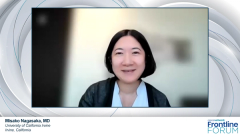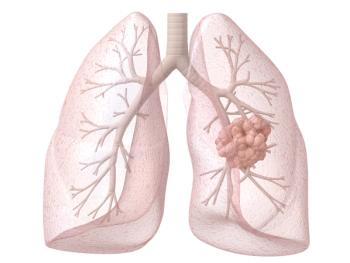
Uncommon EGFR Mutations in Advanced Non–Small Cell Lung Cancer
Shared insight on uncommon EGFR mutations in patients with non–small cell lung cancer and how they fit into the larger disease paradigm.
Episodes in this series

Transcript:
Joshua K. Sabari, MD: We know that, Dr Nagasaka, EGFR mutations are quite common and [there are] so many different types of EGFR mutations. We hear about the activating mutations, exon 19 del[etion], and L858R. But then we hear of a lot of uncommon or more rare EGFR mutations. Can you walk us through how EGFR exon 20 insertion mutations fit within this space of EGFR mutations?
Misako Nagasaka, MD: Yes. Up until recently, we didn’t have inhibitors for EGFR exon 20s, and it’s certainly an exciting time. As you mentioned, Dr Sabari, EGFR mutations, the most common sensitizing ones are EGFR exon 19 deletion and L858R on exon 21, and those account for 80%, 90% of all EGFR mutations. However, there is a small component of other EGFR mutations, and within the other EGFR mutations, there is EGFR exon 20 insertion mutations. Sometimes people get confused with EGFR exon 20 T790M mutations, but totally different. T790M is a resistant mutation that occurs when one is treated with first- or second-generation EGFR tyrosine kinase inhibitors [TKIs]. But what we’re talking about EGFR exon 20 insertion mutations is a de novo mutation that is not considered to be in the common sensitizing group. And until recently, so to be exact, amivantamb was approved in May 2021, and mobocertinib was approved in September 2021. Until recently, we didn’t have inhibitors directed against this particular group of EGFR mutations. So, it’s become an important target to identify.
Joshua K. Sabari, MD: It’s interesting. When you talk to doctors in practice, you hear “EGFR” and you think of osimertinib, a third-generation EGFR TKI. And these 2 things have become synonymous. And, you know, osimertinib is a phenomenal therapeutic in patients with the activating mutations. You mentioned exon 19 del and L858R and exon 21. Why does osimertinib, a third-generation EGFR TKI, not work in patients or not work well in patients with EGFR exon 20 insertion mutations?
Misako Nagasaka, MD: My understanding is that the drug osimertinib does not bind well to EGFR exon 20 insertions because of the shape of how the mutation is.
Joshua K. Sabari, MD: It’s important to note that, again in clinical practice, that third-generation EGFR TKI is not the correct option for this patient population. And I’m always, you know, impressed and surprised in clinical practice when, there is some older data of using double-dose osimertinib, 160 mg, where we saw response rates in the low 20% range, very small studies. But generally, this is not an effective strategy for this patient population. So, Dr Nagasaka, how are you identifying this uncommon or rare EGFR exon 20 insertion mutant [patient] population in your practice?
Misako Nagasaka, MD: So, I send out both tissue and liquid, and I have gotten positive results for EGFR exon 20 insertion mutations in both tissue as well as in liquid. The most important thing here is that we use comprehensive testing or NGS because there are multiple, multiple variants. It’s crazy. It’s every time I check, it used to be 50-plus variants, 60-plus variants, and now there’s 100-plus variants for EGFR exon 20 insertion mutations, and these you cannot check if you’re not doing NGS. So, that is why I use up-front NGS.
Joshua K. Sabari, MD: And you make a good point. Over 100 different EGFR exon 20 insertion mutations, and they can occur in different locations. The helical region, the C-helix, the loop. And maybe some of these therapeutics have different response rates in different locations. It’s possible. We’re still studying that in clinical practice. But, even for me, it’s hard to keep track of all these different variants. Any difference in the variants? Are there some variants that may be more responsive to classical or standard EGFR inhibitors versus others?
Misako Nagasaka, MD: We’re still learning that, to be honest with you. Data that has been published are mainly retrospective from the MD Anderson group. So, we need a bit more data there. But if we’re not checking, we won’t know. Again, I echo the importance of checking, and checking broadly.
Joshua K. Sabari, MD: Couldn’t agree more. A complex space, but understanding that EGFR exon 20 insertions make up a broad array of different alterations. And, you know, something that I also see commonly in practice is if you’re not doing broad-panel NGS and you’re focusing on more piecemeal testing. Imagine if you did IHC [immunohistochemistry] for exon 19 del or L858R, you would miss all exon 20 insertions. Or if you did a PCR-based assay looking for EGFR, you’d miss over half of the EGFR exon 20 insertion mutations. So, I agree with you, Dr Nagasaka. Thinking about the frontline setting, you need to do broad-panel NGS in all patients, and I, too, use both a tissue-based assay as well as a liquid assay. And again, if the liquid is positive, you could act upon it. If negative or nondiagnostic, more importantly, falling back on your tissue-based NGS.
Transcript edited for clarity.
Newsletter
Stay up to date on recent advances in the multidisciplinary approach to cancer.




































































































